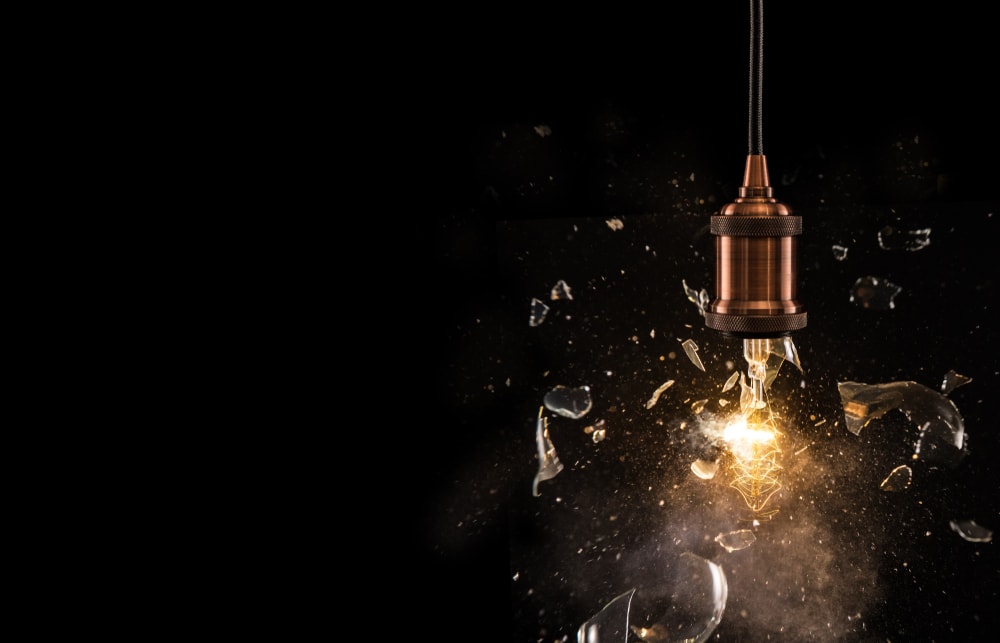Having a light bulb break feels like a really frustrating – and worrisome – moment. Glass on the floor, dangerous parts sticking out, and the possibility of a blown fuse affecting the rest of your home or even hurting you.
Don’t worry though, I’m going to show you how to safely remove a broken bulb from its socket with little more than a potato. (But I’ll also explain what to do in case that doesn’t work too)
Contents
Getting everything ready
1. Safety first
The first thing we need to do is turn off the electricity to the bulb. Sometimes flicking the switch doesn’t do the trick, especially if your lamp has multiple switches or a remote connection. The simplest way is to switch off the power to the light at the breaker in the circuit breaker box.
The next piece of safety advice is to wear gloves. I would suggest using gloves that are cut-resistant, but anything that gives you a layer of protection is better than nothing.
Cut-resistant gloves aren’t expensive and are great for more than just glass handling, they can be used for gardening, wood carving, and basically anything that requires extra protection.
2. Tools for the job
- Gloves
- Like I said before, I suggest “cut-resistant” gloves for proper protection, but any additional layer is better than none.
- Needle Nose Pliers
- Non-Contact Voltage Detector
- Safety Glasses
- Screwdriver
- Hammer (optional, in case the first solution I cover below doesn’t work)
3. Additional materials you’ll need
- Light bulb lubricant
- A potato (I’ll explain the potato later, believe me, it’s crucial!)
Got everything you need? Fantastic! Let’s get to it!
How do you get a broken lightbulb out of the socket with a potato?
We’ll do this in 5 steps. I would suggest you read through this whole process before you make a start, just so you don’t get overwhelmed or miss anything when we get to it.
Also, you may decide that some of the steps aren’t necessary for your situation, and that’s okay. Note that this can also help you remove a light bulb stuck in a fixture too.
Steps for removing a bulb with a potato
1. Verify the power is off
Like I said before, we need to make sure that the power from the circuit breaker is off. But if you think that turning the light switch off is enough for you, or if you (like me) want to make sure that you are 100% safe, then you should now use your non-contact voltage detector.
Put on your gloves and your eye protection, and then check the base of the light bulb with the detector. If there is electricity still in the wires the detector will flash and make you aware of the danger.
If this happens, you should not work on the light bulb! Figure out how the light is getting to the electricity still, and try to stop it.
2. Use the potato
With your trusty raw potato, you should cut off the top to make it fit into the light bulb’s base. This doesn’t have to be perfect. All that matters is that the potato is large enough to take in the bulb but small enough that you can see what’s going on.
Push the cut-side down onto the socket. Press as hard as you can and then twist it counter-clockwise. The glass will connect with the potato creating a strong lock, making it easier for you to twist and pull the bulb out.
3. What to do if the broken bulb is stuck
If the bulb still needs a bit of help, then it’s time to grab your screwdriver and hammer. Put the screwdriver’s tip against the bulb and tap it with a hammer. This should leave the bulb’s metal base in the socket still.
4. The pliers and “wiggling” approach
If step 2 and step 3 didn’t take the bulb out completely, then it’s time to do some fiddly work. Using your needle-nose pliers you want to delicately rotate the bulb by hand.
This can be tough because (unlike the potato that can grab it at all sides) you are only using one area to control at a time. You might need to move positions every now and then.
Remember to go slow, but use force because a delicate touch won’t do much.
5. Preventing more stuck bulbs later
At this point the bulb should be free so your next step is to prevent the new bulb from getting stuck again. Use a bulb lubricant the next time you screw in a light bulb. Lubricant will coat the bulb to prevent corrosion and to make it easy to remove.
Don’t use products like WD-40 or petroleum jelly as they are not designed for light bulbs. You want a lubricant that has been designed for the delicate nature of light.





